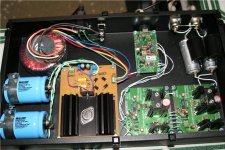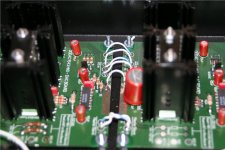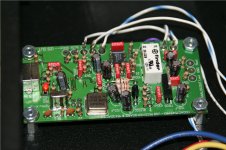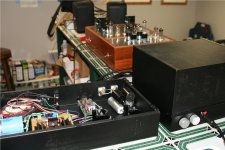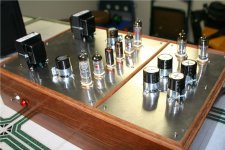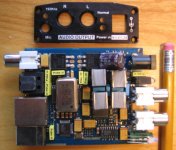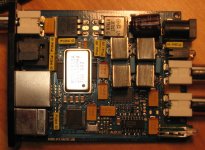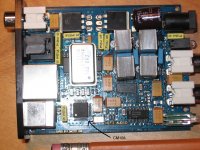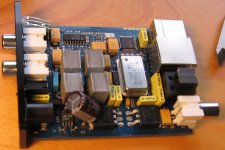Well, I don't know. Perhaps it has something to do with the way my self build amp is grounded...
But with my own power supply, and even with a different 12V switch supply I had in my parts bin, there is no hum at all.
Strange...
But with my own power supply, and even with a different 12V switch supply I had in my parts bin, there is no hum at all.
Strange...
Yup...
I've added a few caps too... Rubycon ZL 470uF 25V in the main power line, a ZLH 100uF 16V in the DAC power supply, and a couple of Wima & couple of Evox film bypasses.
But the latest version comes with a Rubycon YXG 220uF 35V power cap, which is good and doesn't require that you change it. It's necessary to remove it to change the opamp, though...
And as I mentioned I definitely recommend changing the two output caps, with more audiophile-approved Wima MKS2 4.7uF like I did, for instance. [...]
Do you remember what the stock output caps were?
Boy, this thing is tiny (hence the question -- do I really want to even open it??)
No noise problems at all here with the stock power supply. And the one I was sent is a beefy little thing, claiming something like 2.5 amps. The (SuperPro) label suggests one can plug in anywhere up to 24 volts (the stock one is 12). I have a big regulated wall-wart by Elpac here somewhere, 24V, and I may try that too. Although somehow I doubt I'll hear a difference, at least in the computer-based system I have the SuperPro targeted at.
So far so good! Thanks to all for the recommendations on this DAC.
Hi,Do you remember what the stock output caps were?
Boy, this thing is tiny (hence the question -- do I really want to even open it??)
No noise problems at all here with the stock power supply. And the one I was sent is a beefy little thing, claiming something like 2.5 amps. The (SuperPro) label suggests one can plug in anywhere up to 24 volts (the stock one is 12). I have a big regulated wall-wart by Elpac here somewhere, 24V, and I may try that too. Although somehow I doubt I'll hear a difference, at least in the computer-based system I have the SuperPro targeted at.
So far so good! Thanks to all for the recommendations on this DAC.
I understand your concern 🙂 My first impression was just like that. It's tiiiny.
The stock caps were... a pair of 33/47 uF chip-type tantalums 🙂 and they sound good. I'm not sure the Wima MKS2 4.7uF 50V was such an improvement... but definitely the Solen's are.
Anyhow... in a computer based system... and if it sounds good to you (which I think it really does)... do you really want to open (and risk damaging) it??
Last edited:
Peter Daniels NOS DAC, twisted pear buffalo (might exceed budget) and DDDac. This last one offers a lot of different input options.
DIY Chip Amplifier Kits, PCB's, Components and Information.
Twisted Pear Audio
DDDAC 2000
Fran
I've had really good luck with the USB interface using Doede Douma's design Description of the DDDAC1543 MK2 project and a 24 chip version of his DDDAC 1543 DAC. For the amp I am using a Cavalli Bijou with Grado 325i's. I've tried other DAC's, but I keep coming back to the DDDAC. I recently built the Buffalo from Twisted Pear, but it paled in comparison. Even more recently I completed "Franks Ultimate Linestage" to use with the Buffalo instead of the "IVY" linestage. While this did improve the Buffalo's sound, it still couldn't compete with the DDDAC. When I added Frank's linestage between the DDDAC and the Bijou, all I can say is wow! Talk about taking my setup to the next level (and I thought I was already close to being there...). I've decided that it will be worth the expense at some point to add 3 more DAC modules to bring the chip total up to 60 and really open the sound up.
I guess what I am saying is that even with the basic DDDAC (12chip) you would probably be pleased.
Attachments
Hi huskydawg,
what you build looks really nice! But I'm somehow a bit sceptical about the TDA1543 Nos Dacs out there. I've build two DACs before, one with TDA1545 and one with TDA1543, both Nos, both single chip designs. And even though I liked some of there abilities VERY much, there is something with them I couldn't get used to. First, I found Nos Dacs to be very system dependant and not that easy to implement in a already existing chain. Secondly, there is some "openness" to the Nos sound, which I found really nice on great recordings, but fatiguing and straining on not so good recordings. With the Super Pro this is my first Os Dac, and I found it to be more refined than the Nos ones, which makes most of my recordings (especially the old ones, great music, but less well recorded) more listenable.
But perhaps there is really a big difference between one chip (like in my 1543 Nos Dac) and more paralleled ones like in the DDDAC?
How would you honestly describe the pros and cons regarding the sound signature of the DDDAC? I'm would be really interested in reading about that!
Regards!
Martin
what you build looks really nice! But I'm somehow a bit sceptical about the TDA1543 Nos Dacs out there. I've build two DACs before, one with TDA1545 and one with TDA1543, both Nos, both single chip designs. And even though I liked some of there abilities VERY much, there is something with them I couldn't get used to. First, I found Nos Dacs to be very system dependant and not that easy to implement in a already existing chain. Secondly, there is some "openness" to the Nos sound, which I found really nice on great recordings, but fatiguing and straining on not so good recordings. With the Super Pro this is my first Os Dac, and I found it to be more refined than the Nos ones, which makes most of my recordings (especially the old ones, great music, but less well recorded) more listenable.
But perhaps there is really a big difference between one chip (like in my 1543 Nos Dac) and more paralleled ones like in the DDDAC?
How would you honestly describe the pros and cons regarding the sound signature of the DDDAC? I'm would be really interested in reading about that!
Regards!
Martin
Me also sceptical about those DACs. I remember well the TDA1305 and TDA1549 sound... (not that they were bad...just...older 🙂 )
I only have the Buffalo to compare the DDDAC to.
The Buffalo requires more gain adjust on the amp to achieve the same level of volume that the DDDAC requires. The sound of the Buffalo while good, seems sterile when compared to the DDDAC which has a warmth to it. I don't know how else to explain it other then that the music is alive and warm with incredible detail. The addition of Frank's linestage has further increased the level of detail that I am hearing and has made listening exciting again. The better quality recordings are much better sounding with this DAC then the lesser ones as you stated, but even those still sound good as well (they just don't quite have the 'WOW' quality). I don't think you can compare a one chip 1543 DAC to this, because by itself...it is a poor DAC. There is a writeup on Deode's website with testing done on 1 vs 3 chips and the result was quite measurable. I also replaced the caps on the DAC boards with blackgates and am using Russian teflon caps and tantalum resistors on the output (so that probably helps some). For $110 plus shipping though... I might buy one of those super pro's for comparison...
The Buffalo requires more gain adjust on the amp to achieve the same level of volume that the DDDAC requires. The sound of the Buffalo while good, seems sterile when compared to the DDDAC which has a warmth to it. I don't know how else to explain it other then that the music is alive and warm with incredible detail. The addition of Frank's linestage has further increased the level of detail that I am hearing and has made listening exciting again. The better quality recordings are much better sounding with this DAC then the lesser ones as you stated, but even those still sound good as well (they just don't quite have the 'WOW' quality). I don't think you can compare a one chip 1543 DAC to this, because by itself...it is a poor DAC. There is a writeup on Deode's website with testing done on 1 vs 3 chips and the result was quite measurable. I also replaced the caps on the DAC boards with blackgates and am using Russian teflon caps and tantalum resistors on the output (so that probably helps some). For $110 plus shipping though... I might buy one of those super pro's for comparison...
Yup...
I've added a few caps too... Rubycon ZL 470uF 25V in the main power line, a ZLH 100uF 16V in the DAC power supply, and a couple of Wima & couple of Evox film bypasses.
But the latest version comes with a Rubycon YXG 220uF 35V power cap, which is good and doesn't require that you change it. It's necessary to remove it to change the opamp, though...
I think the one I was sent by Cryo-Parts is also the latest version, i.e. that's what they say, and it has the 1364 op-amp. In mine, that power cap is a 150uf 50V. Not sure who makes it -- there's no name on it, maybe (doubtful) you can tell in the attached blurry photo. (I bent the cap up a little to look at the op-amp below.)
Will try for a better pic next time I open this up.
Would be interesting to see what one of these little guys looks like with added/larger electrolytics!
Attachments
I think the one I was sent by Cryo-Parts is also the latest version, i.e. that's what they say, and it has the 1364 op-amp. In mine, that power cap is a 150uf 50V. Not sure who makes it -- there's no name on it, maybe (doubtful) you can tell in the attached blurry photo. (I bent the cap up a little to look at the op-amp below.)
Will try for a better pic next time I open this up.
Would be interesting to see what one of these little guys looks like with added/larger electrolytics!
OK, help me out here (I haven't been paying attention)... The super pro is easily modded for superior sound???
In mine, that power cap is a 150uf 50V. Not sure who makes it -- there's no name on it...
The cap looks to be somebody's "KY" series. Legible in one or both of my new pics of the Super Pro board, here:
Attachments
I think the one I was sent by Cryo-Parts is also the latest version, i.e. that's what they say, and it has the 1364 op-amp. In mine, that power cap is a 150uf 50V. Not sure who makes it -- there's no name on it, maybe (doubtful) you can tell in the attached blurry photo. (I bent the cap up a little to look at the op-amp below.)
Will try for a better pic next time I open this up.
Would be interesting to see what one of these little guys looks like with added/larger electrolytics!
There's a slight change in parts from Super Pro to Super Pro, as it appears.
Mine had a Rubycon YXG 220uF 35V power cap, which looks a bit better possibly than that 150uF 50V. On the other hand, mine doesn't have the blue polyester caps in the low-pass filtering stage, it just has the same yellow polyesters used elsewhere.
Well I guess you would be more interested in seeing the 2.2uF 250V Solen's made to fit in there!! But unfortunately I have got no decent digital camera, plus I don't want to open mine anymore.
Boy, this is a tiny and crowded pcb... Requires a smooth hand when soldering...
I guess mine looks exactly the same, I will open it in a few days after my latest mods to the power supply.
I wonder what these 4 grey block are? Are those caps, and are two of them the output coupling caps?
More important, but not easy to see on your pictures, are there still the 8 holes around the 1364 opamp to solder in a through hole adapter for testing other opamps?
Regarding the cap, no idea what brand this might be. But in my case, I think with a decent power supply very close to the pcb (all in one new case) I think I will left out the 150uF cap completely.
I guess mine looks exactly the same, I will open it in a few days after my latest mods to the power supply.
I wonder what these 4 grey block are? Are those caps, and are two of them the output coupling caps?
More important, but not easy to see on your pictures, are there still the 8 holes around the 1364 opamp to solder in a through hole adapter for testing other opamps?
Regarding the cap, no idea what brand this might be. But in my case, I think with a decent power supply very close to the pcb (all in one new case) I think I will left out the 150uF cap completely.
BTW "who makes it" is Poppulse, as I read on some site selling the Super Pro.
Forgot to say that mine's PCB is green not blue 😛
I'm thinking I might also buy a new one to keep absolutely stock. I'd like to have both flavors at hand..
Forgot to say that mine's PCB is green not blue 😛
I'm thinking I might also buy a new one to keep absolutely stock. I'd like to have both flavors at hand..
Last edited:
Boy, this is a tiny and crowded pcb... Requires a smooth hand when soldering...
I guess mine looks exactly the same, I will open it in a few days after my latest mods to the power supply.
I wonder what these 4 grey block are? Are those caps, and are two of them the output coupling caps?
More important, but not easy to see on your pictures, are there still the 8 holes around the 1364 opamp to solder in a through hole adapter for testing other opamps?
Regarding the cap, no idea what brand this might be.
The KY electrolytic is evidently a Nippon/United Chemicon low-ESR, low-impedance cap with decent specs.
Don't hesitate about opening up the Super Pro -- the board slides in and out very easily, at least on mine. Pretty low-risk.
Yes, the holes are there for a through-hole op-amp. Andrea could tell us for sure, but you might have to do "op-amp rolling" with the case off. I'm not sure there's enough space to stack: a) a socket b) a DIP op-amp c) the power cap, and still accommodate the cover. You could then take the socket out, solder the DIP op-amp to the board, fold down the cap, and put the case back together. Looks like there's enough room for that....
I think that one could fit a slightly longer power cap, if careful about bending the leads around heatsink under the adjoining regulator. See attached pic.
Thanks again to Andrea for information. I would be curious where the other electrolytic (47uf?) was added to the op-amp supply?
In case useful for dating purposes, the serial number on mine (long) ends in 85674....
Attachments
Yours looks the same version as mine. I had a total of 3 of these DACs 🙂 and the former two were different in pcb layout from my last one and yours. 🙂
There are a few apparent differences though in how the board is populated: the power cap (as mentioned), the post DAC filter caps (as mentioned), plus the uF value of a couple of the chip tantalums (probably according to the different pre-LME317 capacitance values).
That other 47uF 25V (Rubycon YXH) was put in parallel with the larger 470uF 25V ZL. I'm a bit obsessed about the power supply 'speed'...
Ah, BTW a socket will fit well (in the current version of the board). Just mount the power cap towards the coaxial digital input instead of towards the power jack. I went as far as using a 10 x 28 mm (1000uF 25V) Rubycon YXH in one of the older Super Pro's. 🙂
There are a few apparent differences though in how the board is populated: the power cap (as mentioned), the post DAC filter caps (as mentioned), plus the uF value of a couple of the chip tantalums (probably according to the different pre-LME317 capacitance values).
That other 47uF 25V (Rubycon YXH) was put in parallel with the larger 470uF 25V ZL. I'm a bit obsessed about the power supply 'speed'...
Ah, BTW a socket will fit well (in the current version of the board). Just mount the power cap towards the coaxial digital input instead of towards the power jack. I went as far as using a 10 x 28 mm (1000uF 25V) Rubycon YXH in one of the older Super Pro's. 🙂
Last edited:
One thing I don't like about this DAC are the RCA jacks. Unfortunately it'd be a little complicated to replace them with others available to me...so I've given up the idea.
BTW, beware... by replacing the LT1364 you're also going to replace its (the DAC's) current sound signature (provided you appreciate it) with something else... more or less satisfactorily.
For instance, the various LM/LME's (LME49720HA excepted) produced a sound in it that might have been be more analytical but wasn't as musically pleasing. I had to wait until the OPA1611 came out before I could put my mind at ease as to what opamp to consider definitive 🙂
For instance, the various LM/LME's (LME49720HA excepted) produced a sound in it that might have been be more analytical but wasn't as musically pleasing. I had to wait until the OPA1611 came out before I could put my mind at ease as to what opamp to consider definitive 🙂
Last edited:
That other 47uF 25V (Rubycon YXH) was put in parallel with the larger 470uF 25V ZL. I'm a bit obsessed about the power supply 'speed'...
Ah, BTW a socket will fit well (in the current version of the board). Just mount the power cap towards the coaxial digital input instead of towards the power jack. I went as far as using a 10 x 28 mm (1000uF 25V) Rubycon YXH in one of the older Super Pro's. 🙂
Thanks, Andrea! I see what you mean about where to situate the cap -- you mean, down over one or both regulators, vs. on top of the op-amp.
I have a few LM4562 op-amps on hand. I have trouble seeing the difference between it and the 49720. In fact, I think at one point, the 49710 was described as a single version of the 4562 (when obviously it is also the single version of the 49720).
I forget, did you try an AD826? Usually, the worry with the 826 is offset current, but the 1364's is much higher....
I know, it's a tough decision to desolder the small 1364, but a few posts earlier you said the rather bright sound signature my be caused by the 1364, and I think, despite nice overall sonics, it's still a bit more on the bright side. That's why I'm thinking about rolling a few other opamps.
In the worst case I think I could order a DIP version of the 1364 to put it back in, if the other opamps are not any better.
In the worst case I think I could order a DIP version of the 1364 to put it back in, if the other opamps are not any better.
- Status
- Not open for further replies.
- Home
- Source & Line
- Digital Line Level
- So many DACs, which to choose
